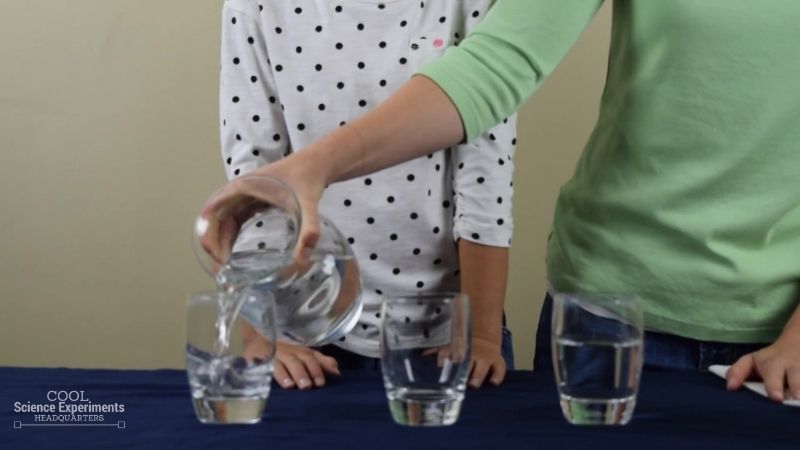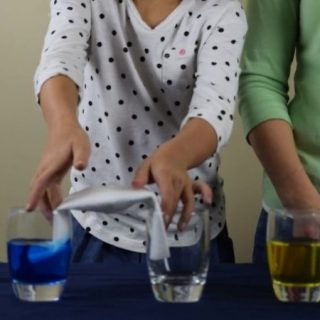Science or magic? This super quick, gravity defying experiment may surprise young scientists and work like magic, but don’t worry! The color changing walking water experiment is science through and through and fun for all ages.
Based on the very popular Walking Water Science Experiment using two glasses, you can observe the water walking AND changing color with only a few supplies you probably already have in your kitchen. This article includes a video to show you just how easy it is with detailed step-by-step instructions and the scientific explanations you need to understand how it works!

JUMP TO SECTION: Instructions | Video Tutorial | How it Works
Supplies Needed
- 3 Glasses of Equal Height
- Paper Towels
- Water
- Food Coloring (Blue & Yellow)
Color Changing Walking Water Science Lab Kit – Only $5
Use our easy Color Changing Walking Water Science Lab Kit to grab your students’ attention without the stress of planning!
It’s everything you need to make science easy for teachers and fun for students — using inexpensive materials you probably already have in your storage closet!
Color Changing Walking Water Science Experiment Instructions

Step 1 – Prepare two strips of paper towel between 1 and 2 inches wide. Tip: We used one section of paper towel and folded it in half and then in half again until it was the correct width. Set the paper towel strips aside and gather the rest of the supplies

Step 2 – Next, Position your three empty glasses about 2-3 inches apart. Pour water into the two outside glasses until they are halfway full. Leave the middle glass empty.

Step 3 – Add a few drops of food coloring to the water. Add blue food coloring to one glass and yellow food coloring to the other glass. Stir the water until the food coloring is fully combined.
Helpful Tip: If you don’t have blue & yellow food coloring, you can use red & yellow or red & blue.

Step 4 – Take one of the strips of paper towel that you prepared in step 1. Place one end of the paper towel into the glass with the blue water. Then place the other end into the glass that is empty.

Step 5 – Take the other strip of paper towel that you prepared in step 1. Place one end of the paper towel into the glass with the yellow water. Then place the other end into the glass that is empty.
Take a moment to make some observations. What happened to the paper towel that was placed in the water? Do you think it is possible for the water in the first glass to move to the empty glass? What do you think will happen if the water moves to the middle glass? Write down your hypothesis (prediction) and then leave the glasses to sit and come back to check on them in about an hour.

Step 6 – Return to the glasses and observe what has happened. What happened during the hour you were waiting? What do you think will happen if you wait a little longer. Do you think all the water in the outside glasses will move to the middle glass? Why or why not? Write down your hypothesis (prediction) and then leave the glasses to sit and come back to check on them in two hours.
Color Changing Walking water Science Experiment Video Tutorial
Color Changing Walking Water Science Experiment Step by Step Instructions
How Does the Experiment Work?
Why Does the Water Move Between Glasses?
The water appears to defy gravity, but in reality, it moves because of a process called capillary action. Water is able to move against the force of gravity because water molecules stick to each other AND they stick to the fibers of the paper towel. As water molecules are attracted to the fibers of the paper towel, they pull other water molecules with them. The adhesive forces between the water and the fibers of the paper towel are stronger than the cohesive forces between the water molecules. This allows water to travel from one cup to another.
Capillary action is the combined force of attraction among water molecules and with the molecules of surrounding materials.
Why Does Water Change Color?
Did you know that three basic colors can combine together to make any other color? These three basic colors are red, blue and yellow. They are referred to as primary colors. When two primary colors combine in equal amounts, they produce a secondary color. In this experiment, we chose blue and yellow (two primary colors) for the outside glasses. When the blue and yellow water mixed in the middle glass it turned green (a secondary color).
Color Changing Walking Water Science Lab Kit – Only $5
Use our easy Color Changing Walking Water Science Lab Kit to grab your students’ attention without the stress of planning!
It’s everything you need to make science easy for teachers and fun for students — using inexpensive materials you probably already have in your storage closet!
More Science Fun
Eventually, the water will stop moving over once both cups are filled with the same amount of water. Expand on the experiment, by estimating how long it will take for the water to move to the second jar. Then set a timer and find out how close your estimate was.
You can also try this experiment with other colors!
Red + Yellow = Orange
Red + Blue = Purple
In addition, you can also try these other fun experiments that contain mixing colors:
- Coloring Changing Water Science Experiment – Science or magic? Try this experiment at home with your kids and watch their eyes light up as you pour the liquid into the bowl and “create” a new color.
- Discover How Colors are Made – This is a simple experiment that demonstrates how different colors are made.
I hope you enjoyed the experiment. Here are some printable instructions:

Color Changing Walking Water Science Experiment
Materials
- 3 Glasses of Equal Height
- Paper Towels
- Water
- Food Coloring (Blue & Yellow)
Instructions
- Prepare two strips of paper towel between 1 and 2 inches wide. Tip: We used one section of paper towel and folded it in half and then in half again until it was the correct width.
- Once you have your two paper towel strips ready, set them aside.
- Next, Position your three empty glasses about 2-3 inches apart.
- Pour water into the two outside glasses until they are halfway full. Leave the middle glass empty.
- Add a few drops of food coloring into the water. Stir the food coloring until the water is all one color. Tip: Use blue food coloring in one glass and yellow in the other.
- Take one of the strips of paper towel that you prepared in step 1. Place one end of the paper towel into the glass with the blue water. Then place the other end into the glass that is empty.
- Take the other strip of paper towel that you prepared in step 1. Place one end of the paper towel into the glass with the yellow water. Then place the other end into the glass that is empty.
- Observe the experiment right away. Do you notice that the water is “walking” up the paper towel? Now, leave the glasses alone and come back to check on them in an hour or two.
- Return to the glasses and observe what has happened.Tip: The longer you wait to check on the glasses, the more water will have moved to the middle glass. The water will stop moving over when all of the cups are filled with the same amount of water.



I want many science experiments for my kids.Thanks for your sharing.
Thank you because I really needed something to do for my science fair and now i’m good to go